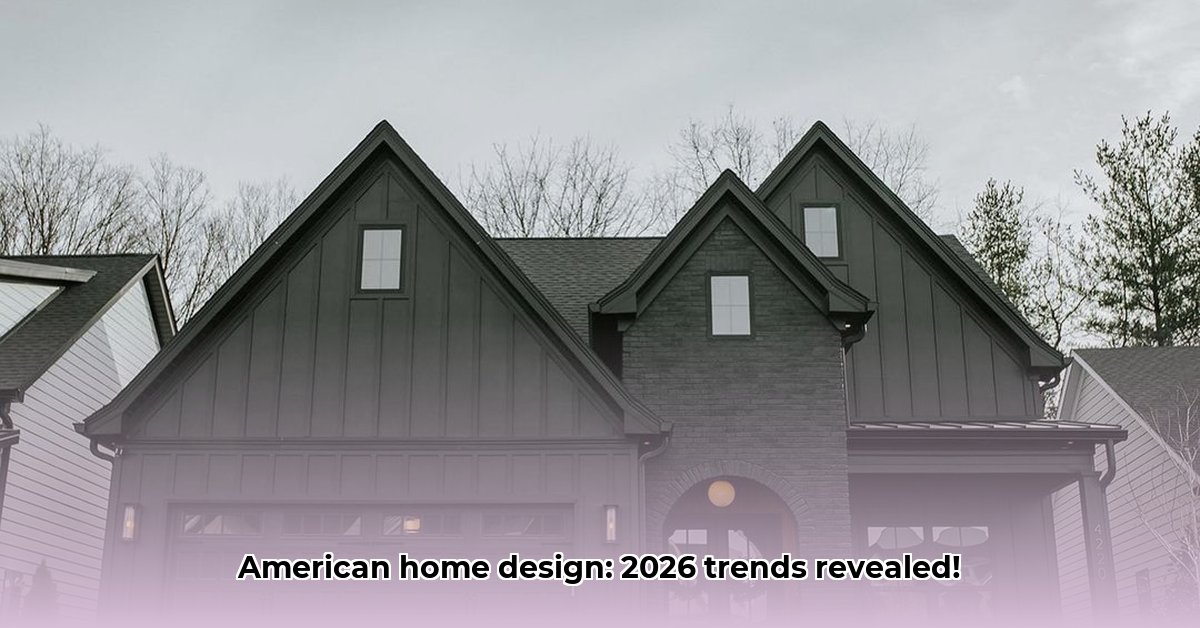Thinking about building or buying a new house in the next few years and need to prepare for what the future brings? This article breaks down the two hottest styles right now: Modern and New American homes. We’ll show you what makes them different, what’s popular now in terms of architectural trends, and how to make the best design choice for you and your home. For more American home design ideas, check out these designs.
Exploring the Future of American Home Architecture
Let’s explore the hottest styles shaping American architecture in 2026 and beyond, including building materials, regional preferences, and technological integrations. Two leading contenders – the New American and the Modern styles – offer distinct approaches to home design, each with its own unique appeal. With the rise in eco-consciousness, how do these styles incorporate sustainable building practices, and what impact do smart home features have on daily life?
New American Design: A Modern Twist on a Classic Aesthetic
The New American home design is having a major moment, offering the perfect blend of classic charm and modern convenience. Imagine a welcoming front porch, the gentle slope of a gabled roof overhead, and an open and airy floor plan, maximizing sunshine through large windows. It’s a style that feels instantly comfortable and family-friendly, boasting warm wood accents, the earthy tones of stone, and the sturdy reliability of brick – these elements create a home that’s both stylish and supremely practical. This design is all about creating a space that feels inviting and lived-in, a comforting haven to come home to. The versatility of the New American style also allows for easy customization, ensuring that each home reflects the personal tastes and lifestyle of its occupants.
Modern Design: Sleek, Sustainable, and Seriously Stylish for 2026
The Modern American home is all about clean lines, maximizing space, and embracing energy efficiency. Think minimalist aesthetics, wide-open spaces, and a focus on functionality. You’ll often see sleek exteriors, walls of windows that flood the interior with natural light, and dramatic architectural elements like dramatic overhangs and soaring ceilings. Many contemporary designs also incorporate eco-friendly materials and practices, reflecting a growing awareness of our environmental impact, resulting in stunning homes that are as efficient as they are beautiful – stylish, sustainable living spaces. Modern designs prioritize not only aesthetics but also environmental responsibility, incorporating features like solar panels, rainwater harvesting systems, and passive heating and cooling strategies. How can homeowners ensure that these large windows offer adequate insulation, and what are the latest innovations in energy-efficient glass technology?
Exploring Key Style Differences: A Comparative Analysis
Let’s break down the key differences between these two popular styles:
| Feature | New American Style | Modern Style |
|---|---|---|
| Exterior | Traditional features like gabled roofs, a mix of materials (wood, brick, stone), inviting front porches. | Clean, sharp lines, often featuring large windows and minimalist materials like concrete, steel, and glass, flat or low-sloped roofs. |
| Interior | Open layouts, often emphasizing coziness and natural light, traditional trim work. | Open, airy spaces with minimalist decor and a focus on functionality, exposed structural elements. |
| Materials | Natural materials like wood, stone, and brick are common, combining textures for visual interest. | Modern materials like concrete, steel, and glass are prioritized, often used in innovative ways. |
| Overall Feel | Warm, inviting, and classic with a touch of modern practicality, comfortable and family-friendly. | Chic, efficient, and often minimalist with a strong emphasis on natural light, creating a sense of spaciousness and tranquility. |
Market Trends & Future Directions in Modern American Homes
Both New American and Modern styles are flourishing right now, which tells us that homeowners have diverse tastes and preferences. Builders will need to offer a wide variety of choices to keep up with demand and architects are likely to continue experimenting with blends of the two styles, creating unique and exciting hybrid designs. Interior designers will adapt their styles to perfectly complement each architectural aesthetic. The growing popularity of accessory dwelling units (ADUs) is also influencing home design, providing flexible living spaces for extended families or rental income. What design choices can make these homes more energy-efficient, and how are smart home technologies being integrated to enhance comfort and convenience?
Looking ahead, a few key trends are likely to significantly influence the future of home design, including sustainable building practices, smart home integration, and a focus on wellness. More and more buyers are prioritizing long-term value and environmental responsibility.
This suggests a future where sustainability and functionality are as important as aesthetics, creating homes that are both beautiful and environmentally conscious. We’re likely to see innovative designs that minimize environmental impact while maximizing comfort and convenience, with an ongoing exploration of eco-friendly materials and energy-efficient technologies. The integration of biophilic design principles, which connect occupants to the natural environment, will also play a significant role in creating healthier and more enjoyable living spaces. The future of American homes will likely be a fascinating blend of classic and modern styles, with a strong focus on sustainability and smart living.
Comparing Energy Efficiency: Modern vs. New American House Designs
Understanding how these styles approach energy consumption, will determine long-term financial and environmental impact.
To help guide your decision-making, consider these factors:
- Efficiency Differences: Both styles have unique energy efficiency challenges and opportunities, requiring careful consideration of design choices.
- Holistic Analysis: Energy performance must be examined beyond aesthetics, considering factors like insulation, HVAC systems, and renewable energy sources.
- Professional Energy Audits: Consulting an energy auditor is crucial for informed decisions, providing objective data to guide your choices.
Understanding Modern and New American Home Aesthetics
Modern American homes, often characterized by clean lines, open floor plans, and large windows, present both opportunities and challenges regarding energy efficiency. While the emphasis on maximizing natural light is aesthetically pleasing, it requires careful consideration of glazing types and shading strategies to prevent excessive heat gain in summer. New American homes, on the other hand, typically feature more traditional styling, often incorporating porches, gables, and more complex rooflines that might lead to a greater surface area needing insulation, which could impact energy consumption. Integrating smart home technology into either style allows for optimized energy usage. Is there a way to balance style versus energy savings, and what are the latest advancements in building science that can improve energy performance?
Evaluating Building Materials for Energy Efficiency
Modern homes frequently use concrete, steel, and glass, materials with varying thermal properties. Concrete has high thermal mass, helping to regulate indoor temperatures, but it also requires more energy for initial heating. New American designs often employ wood framing, known for its good insulation properties, especially when paired with proper insulation techniques, but susceptible to heat transfer if not well-insulated. The embodied energy of building materials, the energy required to extract, manufacture, and transport them, is also an important consideration. As such, the choice of materials significantly influences energy performance.
Assessing Insulation and Air Sealing Techniques
Proper insulation is paramount. Modern homes, with their often larger expanses of glass, need superior insulation to counteract heat loss or gain through windows. Look for high-performance windows with low U-values (indicating better insulation) and consider strategic placement of windows to minimize solar heat gain during peak hours. Similarly, New American homes, with their irregular shapes and potentially greater surface area, benefit from comprehensive air sealing and thorough insulation in walls, attics, and crawl spaces. Both styles need airtight construction to minimize energy waste caused by drafts. Emerging insulation materials, such as aerogels and vacuum insulation panels, offer even greater thermal resistance for both styles.
Examining HVAC Systems
HVAC (heating, ventilation, and air conditioning) systems play a crucial role in energy consumption. Modern designs often incorporate energy-efficient HVAC units, sometimes complemented by radiant heating or cooling systems that utilize the building’s thermal mass, as opposed to New American homes that may include more traditional forced-air systems, which, while often less expensive upfront, can be less efficient unless properly sized and maintained. Geothermal heat pumps are another option to consider. Consider the efficiency ratings of HVAC systems (SEER for cooling, AFUE for heating) when comparing energy performance. What is an ideal SEER rating for a modern, energy-efficient home, and how do smart thermostats contribute to energy savings?
Sustainable Features and Technological Advancements
Modern homes are more likely to incorporate renewable energy sources, such as solar panels, and smart home technologies to improve energy management. New American designs are not necessarily excluded from these advancements, but their integration might be less common. Smart home systems can automate lighting, temperature, and appliance usage, optimizing energy consumption based on occupancy and environmental conditions. Think about the long-term environmental and financial implications of these features. Will solar panels offset upfront costs over the lifetime of the home? Does the smart thermostat significantly reduce energy waste? Battery storage systems, which store excess solar energy for later use, are becoming increasingly popular.
Importance of Professional Energy Assessment of Home Designs
For an objective comparison, a professional energy audit is essential. An auditor can identify areas of energy loss or gain in both Modern and New American homes, providing precise data to guide decision-making. This helps avoid relying solely on superficial assessments of style. Blower door tests, which measure air leakage in a building, are a valuable tool for identifying areas that need improvement. What are the key metrics an energy auditor uses to assess a home’s efficiency, and how can homeowners use this information to make informed decisions about energy upgrades?
[https://www.energy
- Glass Tile Shower Ideas to Create a Stunning Bathroom Space - December 7, 2025
- Glass Wall Tile Ideas for Kitchens and Bathrooms - December 6, 2025
- Glass Tile Bathroom: Create a Beautiful, Easy-Clean Space - December 5, 2025










